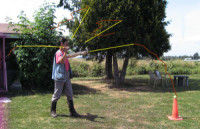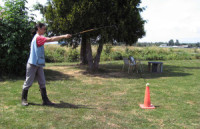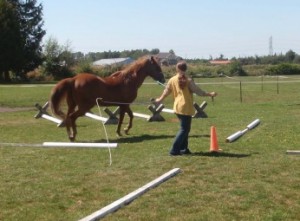The Lungeing Whip:
- Especially with young horses the whip must be introduced gently: the horse should not fear the whip. For this it is very useful to introduce its touch with friendly games – use a whip with a short lash as “tail” and swish the flies off your partner – THAT is a friendly gesture which he understands, as in the herd they help each other out precisely like this. Calm and rhythmic movements are very important – rhythm is a sign of friendship for horses!
- The whip should be light and lie balanced in your hand. For training, it should be long enough to reach, so the lunger is able to influence the horse with the thong precisely to a point.
- For vaulting we use particularly long (over 3 m long) telescope whips, which are not easy to apply accurately. Including the thong one thus has a reach of up to 8 meters. It is important to buy or make yourself a light whip (fishing rods of carbon are very good!), as otherwise your arm will get tired very quickly.
The role of the whip:
- The whip has an active and a passive role. The passive whip points calmly to the hock of the horse, and always to the same point, as the lunger rotates or walks with the horse on the circle. The whip is mainly there to frame the horse and to recover possibly slacking attention. But here too the voice aid should always come first! It is the fair warning to the horse that, if he does NOT pay attention (any horse has it programmed in his genes that he must always pay attention to his leader!) a sharper reminder with the whip, perhaps even a punishment (which we always try to avoid), will follow. To call a horse to order which has not even yet heard what you want from him would be very unfair.
- THAT must be the contract between trainer and horse: ALWAYS first the polite request, THEN a command, THEN the insistence on compliance in phases, which must first be as light and friendly as possible.
- The whip becomes active in careful gradation of impact, exactly restricted to the necessary! When the whip gets raised, this is an urgent invitation to react – and a reaction must follow! If it does not, flick the whip – that is an earnest warning. If you need to touch the horse with it, this is already considered a punishment.
|
|
Die Longierpeitsche:
- Die Peitsche muß, vor allem bei einem jungen Pferd, behutsam eingeführt werden: das Pferd darf die Peitsche nicht fürchten. Hierzu ist es sehr nützlich dem Pferd die Berührungen als freundliches Spiel nahe zu bringen – benutzen Sie eine kürzere Peitsche mit Schlag als “Schweif” und wischen Sie damit Ihrem Partner die Fliegen fort – DAS ist eine Freundschaftshandlung, die es sofort versteht, denn in der Herde machen es die Freunde genauso. Ganz wichtig hierbei sind ruhige und rhythmische Bewegungen – Rhythmus ist ein Zeichen von Harmonie!
- Die Peitsche soll leicht und gut in der Hand liegen. Beim Training sollte sie lang genug sein, damit der Longenführer mit dem Schlag punktgenau auf das Pferd einwirken kann.
- Für Voltige werden besonders lange (über 3 Meter) Teleskoppeitschen verwendet, die nicht einfach genau zu handhaben sind. Mit Schlag hat man damit eine bis 8 m Reichweite. Es ist wichtig eine Peitsche aus Leichtmaterial zu erwerben (Angelruten aus Carbon sind hier sehr vorteilhaft!), da der Arm des Longierers sonst sehr schnell ermüdet.
Die Rolle der Peitsche:
- Die Peitsche hat eine aktive und eine passive Rolle. Die passive Peitsche zeigt ruhig auf die Sprunggelenke des Pferdes, immer auf die selbe Stelle, da der Longenführer ja mit dem Pferd auf dem Zirkel mitgeht oder sich mitdreht. Die Peitsche sollte hauptsächlich dazu da sein das Pferd einzurahmen und eventuell nachlassende Aufmerksamkeit wieder herzustellen. Auch hier sollte aber immer die Stimmhilfe vorausgehen! Sie ist die faire Warnung, daß, wenn nicht beachtet (denn ein Pferd hat in seinen Genen verankert, daß es immer auf sein Leittier achten muß!) eine schärfere Aufforderung mit der Peitsche, oder gar eine Strafe (die wir immer zu vermeiden suchen) folgen wird. Ein Pferd zur Ordnung zu rufen, welches ja noch gar nicht zu hören bekam, was Sie von ihm wäre sehr unfair.
- DAS muß der Vertrag zwischen Ausbilder und Pferd sein: IMMER erst eine höfliche Aufforderung, DANN ein Kommando, DANN das Bestehen auf Befolgung in abgestuften Phasen, die so leicht und freundlich wie nur irgendmöglich sein müssen.
- Die Peitsche wird aktiv in vorsichtiger Abstufung der Einwirkung, strikt auf das Notwendige begrenzt! Wenn die Peitsche sich hebt, ist das eine dringende Aufforderung auf die eine Reaktion erfolgen muß! Wenn das Pferd dies nicht beachtet, schnickt man die Peitsche – und das ist nun eine ernsthafte Warnung. Wenn das Pferd mit der Peitsche berührt werden muß, ist dies schon eine Strafe.
|
- Some lunging trainers sink the whip behind the horse as a request to step more actively. As long as the horse was conditioned like this consistently this is of course also all right – in the end it is only the consistency and the result which counts. But as we saw in the body language of the previous video clips (blog 05), sinking the arms is a sign to slow down, so such a whip aid for stepping more actively would not make sense to the horse. Also, if I plan to touch the horse in the following phases (when I have to intensify my aids, because the horse does not comply) then sinking the whip is not logical for me: when I have to touch the horse I do it higher up (I aim for the croup) – and to do this I have to raise the whip! In over 30 years of lunging for vaulting I have learned that this is the least dangerous spot: touching him on the croup I do not risk to wrap the lash around the horse’s legs, causing a panic and stampede.
Touching points for the whip:
- Touching with the end of the thong, exact and to the point, especially with a long whip (such as the common vaulting whips), is very difficult and needs a lot of practice – please do this on a lifeless object first! Hitting a traffic cone with a tennis ball on top or a beer can on a jump post are good target practice for this.
 Aim with the tip of the stick toward the ball.
Zielen Sie mit der Spitze des Stocks auf den Ball.
- Consider also that you must be equally proficient with your right and your left hand to be an effective trainer. Avoid touching the lash at your horse’s hind legs – especially when vaulters are on top! The chance that the thong gets caught and the horse panics is much too probable. Train to throw the thong that you can gently touch the horse directly on the croup. Especially in vaulting, where in many exercises the smallest vaulter is in the highest position above the ground, the very precise and feather-light application of the whip, when the horse threatens to break his canter, is an absolute requirement.
- Whip aids may not be applied constantly, as the same is valid like for all other aids: they must stop instantly as soon as the horse has shown the desired reaction (during schooling also if only partially!). If the horse already does the right thing, which you requested by lifting the whip, then it cannot understand you. Indeed, if you continue to flick it, a very motivated horse would then try something else, because he would think that he has not yet hit on the correct solution (and does try to make you happy). If then he gets punished for this attempt the trust is destroyed – the horse becomes frustrated and might in future deaden to your aids (which are not aiding) or ignore them and you altogether.
- Equally important is to apply the whip (as friendly and gently as possible) in a determined way, when the horse has not reacted to your voice command! A prompt, instant reaction of the horse must occur, if you want to be respected as a consistent trainer. Here you must observe yourself very critically to be able to stay fair: was your command really clear enough? Was the horse inattentive or did he just show a very tentative reaction, because he was insecure?
How to apply whip aids is to be continued in the next blog. |
|
- Es gibt Longenausbilder, die ein Absenken der Peitsche hinter dem Pferd als Aufforderung zu fleißigerem Antreten benutzen. Solange das Pferd hierauf erfolgreich konditioniert wurde, ist das natürlich in Ordnung – am Ende zählt immer nur die Konsequenz und das Resultat. Aber wir sahen in den Video Clips über Körpersprache (letzter Blog 05), daß ein Senken der Arme ein Kommando zum Langsamerwerden ist, so daß so ein Peitschenzeichen zum fleißigeren Antreten für das Pferd unlogisch wäre. Auch wenn ich plane in den folgenden Phasen (wenn ich die Hilfen bei Nicht-Befolgung verstärken muß) das Pferd zu touchieren, ist das Absenken der Peitsche für mich unlogisch: denn ich touchiere, wenn, dann höher (ich ziele in Richtung Kruppe) – und dazu muß ich die Peitsche anheben. In 30 Jahren Longieren für die Voltige habe ich gelernt, daß diese Touchierstelle die ungefährlichste ist – hier laufe ich nicht Gefahr, daß sich der Schlag der Peitsche um die Beine des Pferdes wickelt und ein Losrennen hevorruft.
Touchierpunkte für die Peitsche:
- Ein punktgenaues Treffen mit dem Ende des Schlages, vor allem mit einer sehr langen Peitsche (wie beim Voltigieren gebraucht), ist sehr schwierig und braucht viel Übung – die Sie bitte an einem leblosen Gegenstand vornehmen! Ein Kegel mit Tennisball oder eine Bierdose auf dem Sprungständer sind gute Probierziele hierfür.

- Bedenken Sie auch, daß Sie rechts- und linkshändig gleich gut mir der Peitsche umgehen können müssen, um ein effektiver Trainer zu sein.
- Schlingen Sie nicht den Peitschenschlag um die Hinterhand des Pferdes – vor allem nicht im Voltigiertraining!! Da ist die Gefahr, daß man hängenbleibt und das Pferd in Panik verfällt viel zu groß. Üben Sie die Schnur so zu werfen, daß sie zielgenau mit dem Ende auf der Kruppe berührt. Vor allem beim Voltigieren, wo in manchen Übungen das kleinste Kind sich am höchsten in der Luft befindet, ist eine absolut federleichte Anwendung der Peitsche bei sich androhendem Ausfallen des Pferdes Voraussetzung.
- Peitschenhilfen dürfen niemals ständig angewendet werden, denn hier gilt dasselbe, wie bei den Stimmhilfen: jede Hilfe muß sofort aussetzen, wenn das Pferd richtig reagiert hat (während der Ausbildung auch wenn nur im Ansatz!). Wenn das Pferd ja schon das Richtige tut, was Sie mit einem Anheben der Peitsche verlangt haben, dann kann es nicht verstehen, warum Sie immer weiter verlangen – ein sehr williges, motiviertes Pferd würde dann etwas anderes versuchen, denn offensichtlich hat es ja die richtige Lösung noch nicht gefunden (und versucht es Ihnen recht zu tun)! Wenn Sie es dann auch noch strafen, ist das Vertrauen zerstört – das Pferd wird frustriert und wird Sie und Ihre Hilfen (die ja nicht helfen) in Zukunft ausblenden und abstumpfen.
- Ebenso wichtig ist es aber, die Peitsche (so maßvoll und freundlich wie möglich) aber bestimmt einzusetzen, wenn das Pferd nicht auf den Stimmbefehl geachtet hat! Eine prompte, unmittelbare Reaktion des Pferdes muß erfolgen, wenn Sie als konsequenter Trainer respektiert werden wollen. Hierbei müssen Sie immer sich selber kritisch betrachten, um fair bleiben zu können: war Ihr Kommando wirklich klar genug? War das Pferd wirklich unaufmerksam oder hat es lediglich aus Unsicherheit eine zu zögerliche Reaktion gezeigt?
Im nächsten Blog geht es weiter mit der Anwendung korrekter Peitschenhilfen.
|




